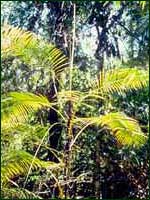Rattans
Almost synonymous with fine articles of world-famous Philippine handicrafts, such as furniture, baskets, cords, and walking sticks, rattans (Calamus) are climbing members of the palm family. Creeping and twisting along the forest floor and climbing tall trees to reach sunlight in the canopy, rattans can be 150 meters long. Rattan cane comes from pieces of the jointed stem, the distance between joints reaching more than a meter. Unlike bamboo, rattan is solid inside, and unlike wood, its fibers run the length of the plant in a single direction. These characteristics give rattan remarkable strength and flexibility.
The young parts of these climbing palms are usually armed with numerous stiff, needle-sharp spines. The leaf stalks are also spiny, as are other parts of theplant, which may also have stout and sharp claws. Most of us who have ventured into the forest have unpleasant memories of being snagged by the spines of the stems. The long, whip-like extensions of the leaves can lift off your hat or grasp your shirt. Once entangled, only discretion and patience will rid you of these exasperating snares.
Harvesting rattans in the wild demands great courage and skill. Because of over-harvesting in more accessible locations, rattan is currently sought in very steep and treacherous areas, including 100-meter sheer cliffs. In 1987, a harvester was killed in a fall from one such cliff near our field camp on Leyte.
Most of the 80-plus species of rattans in the Philippines are endemic. One, Calamus merrillii, locally called palasan, is officially listed as a threatened species due to excessive harvesting. In the past, rattans were classified as minor forest products, but today they are an increasingly valuable commodity. The incentive to collect them as a supplementary source of income for people living near the forest will certainly put pressure on the remaining populations. In the Philippines, the rattan is not cultivated, but only extracted from the wild.
Original URL: http://archive.fieldmuseum.org/vanishing_treasures/V_Rattans.htm\

